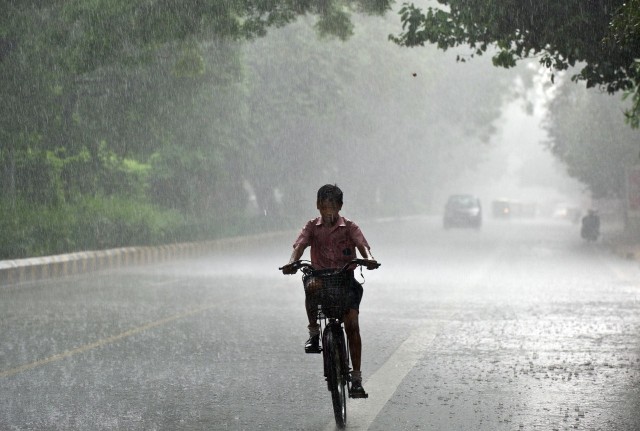monsoon
THE HEAVY RAINS of the monsoon appear in June and subside in September every year in the Northern Hemisphere. Meteorologists and scientists are greatly helped by the development of sophisticated weather analysis and forecasting technology in understanding monsoon mechanisms. Numerous people on the earth are affected by this significant climatic system. The monsoon directly governs the destiny of cultivators in South, East and Southeast Asia, as farming is heavily dependent on the seasonal rains. The summer monsoon winds bring heavy showers over most of South Asia.
An improved understanding of monsoons has embraced the majority of the phenomena connected with the weather system in the tropical and subtropical part of the Asian, Australian, and African continents and the neighboring water bodies. ARIZONA, NEW MEXICO, UTAH, and COLORADO in North America are also affected by monsoons in late summer.

A monsoon-type of climate is associated with wet summers and dry winters. The word monsoon seems to be derived from the Arabic word mausim, meaning “seasons.” It is recurrently misused as a synonym for “heavy rainfall,” though the misnomer is justified. Ancient merchants used the word to explain a system of seasonal reversal of wind while sailing over the INDIAN OCEAN and adjacent Arabian Sea. Their direction of sailing movement was governed by these seasonal winds. The winds gust steadily from the southwest during one half of the year (summer) and from the northeast during the other (winter). Thus, monsoon has been defined by climatologists as a large scale wind system that predominates or strongly influences the climate of large regions, and in which the direction of the wind flow reverses from winter to summer.
Three essential mechanisms are involved in causing monsoons: 1) differential heating and cooling of land and water, as land absorbs/releases heat faster than the water; 2) deflection of wind in response to the Coriolis effect, caused by the rotation of the Earth; and 3) latent heat exchange—the exchange of energy involved while changing the state of water from liquid to vapor and back.
The most renowned of the entire monsoon is the Asian monsoon, which is truly a seasonal, cyclic climate. To understand the causes for the seasonality, certain dynamics need to be analyzed. During the summer, the sun is vertically over the Asian continent. The Central Asian landmass gets intensely heated, resulting in expansion and ascension of air above the surface, creating a low-pressure area over Central Asia. Alongside it, the INDIAN OCEAN watermass remains relatively cooler, making a high-pressure region.
The variation in temperature between landmass and water could be much as 68 degrees F (20 degrees C). Such differential heating and cooling causes the moisture-laden air from the Indian Ocean to move toward South and Southeast Asia. This occurs because wind essentially moves from high pressure to low pressure regions. As the wind is deflected toward the right in the Northern Hemisphere (Coriolis effect), these winds become southwest monsoons. During the fall, landmass and water begin to cool and the land starts losing heat faster than the ocean.
Therefore, in the winter, the pressure system reverses because the cold polar airmass moves southward, and Tibet and the surrounding areas in the north become a high-pressure center. The Indian Ocean, over which the sun rays fall directly, turns into a low-pressure zone. Thus, the wind direction is reversed, becoming the northeast trade winds of the winter.
Another important factor that directs the commencement or disappearance of summer monsoons in Asia is the situation of the upper-level JET STREAMs. These are a “meandering belt of strong winds in the upper atmosphere,” as explained in Introduction to Geography by Arthur Getis et al.
When a lofty mountain system like the HIMALAYAS lies in its path, the westerly jet streams divide into two branches (south and north of the Himalayas). These two branches prevail from November through April. The disappearance of the jet streams south of the Himalayas in November causes the sudden “retreat” of monsoon rains from Asia. During the months of July and August, there is an easterly jet stream prevailing over the Indian peninsula.
The southwest winds produce most of the rainfall over the entire Indian subcontinent. These winds, however, ignore Rajasthan or the THAR DESERT of INDIA and western PAKISTAN because they are deflected by the earth's rotation (Coriolis effect) toward the northeast, and, therefore, the northwestern part of the subcontinent remains relatively dry. There are only 20 rainy days in Kutch (India), and some places in the Rajasthan desert have fewer than five rainy days in a year. Nevertheless, a large part of India, BANGLADESH, and Pakistan receive protracted heavy rains and associated flooding.
The monsoon provides valuable and abundant water to Asia. Most of the monsoon climatic region that encompasses South, East, and Southeast Asia supports agrarian economies dependent on rainfall. Consequently, the route of the monsoon winds decides the fate of the region. Deviation of the monsoon from its normal pattern disturbs agriculture operations, which can become disastrous for rain-dependent agrarian economies.
Unfortunately, the pattern, distribution, amounts, and magnitude of rainfall vary considerably each year. The variability can lead to severe drought and floods that can significantly amplify the price or reduce the availability of food. Immense deviation from the normal pattern might ultimately lead to famine. Correct forecasting of the onset of the monsoon has become absolutely indispensable. Computer models of monsoons are intricate and need to be precise; helping to alleviate the implication of a weak monsoon.